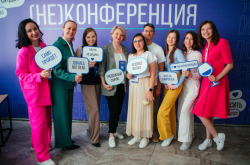How does birdwatching actually takes place?
Birdwatching is basically regular people watching birds in their natural habitat. Though the English term sounds a little odd, it’s starting to take root in the Russian language because under this name the hobby has spread around the world.
Basically, anyone can be engaged in birdwatching: you can simply watch the birds in the nearest park, or you can go to the other end of the Earth to see a rare bird. Birdwatchers around the world participate in competitions - who saw and identified more birds in a day, a year and even for a lifetime. There are such competitions in our country, too, but few know about them. It’s not easy to learn to identify birds without any help - it's best to begin acquaintance with them in the company of an experienced ornithologist, for example, on an ornithological excursion that take place in many cities around Russia. In St. Petersburg they are conducted by Sergey Petrov with the Zoological Institute of the Russian Academy of Sciences.
Birdwatching is very affordable: All you only need is binoculars and a guide book for birds in your area. The best of them are made with drawings, not photographs, because professional drawings represent a typical image of a bird and in a photograph you’ll always see a specific individual that may differ from other representatives of its species. There’re now also mobile applications for identifying birds, with the best being Merlin by CornellLab.

How popular is it around the world?
According to some estimates, it involves about 90-100 million people, including photographers and artists who take photos and draw the birds. It’s also the basis for ornithological tourism, which is still in its infancy in Russia. Interestingly enough, exclusive ornithological tours to Russia’s distant corners became available to foreigners probably before they became available to Russians. There’s a vast market for apps that identify and document birds in various territories. But in Russia it’s still in its infancy.
So why is birdwatching underdeveloped in Russia?
It makes more sense to ask why it hasn’t become a mass culture phenomenon here. Of course, there are people here who are keen on ornithology, both professionals and amateurs. But compared to Europe and USA, there’s not enough of them on the vast territory of our country to build a critical mass that would put this movement on the map.
If you take eBird, where birdwatchers from around the world mark the birds they encountered, the online map of Russia is a mostly empty space. But there are over 750 species of birds here, about 100 more than in all of Europe. I think that for birdwatching to become truly popular we need some sort of bestseller: a movie, a book or an app. For example, when “The Big Year” Hollywood film was released, it caused a major jump in interest towards birdwatching.

Would people be interested in it? Right now, for example, people are pretty interested in technologies because everyone has a smartphone and access to the Internet.
Everyone likes birds and animals but very few people know anything about them. The school curriculum in biology is often boring and only discourages the natural interest in the animal world. In the Soviet Union, there was a program called “In the World of Animals,” which fueled the interest in nature. But when everything fell apart in the 1990’s, this topic went away too. To this day there are very few quality movies, programs and books about the diversity of our flora and fauna, and they rarely reach the mass audience. But people are still interested in nature.
On my ornithological excursions in Yekaterinburg, many people not only want to learn about local birds but also ask whether there are similar excursions about plants, insects - people are interested in everything. I try to recruit colleagues to conduct such nature tours “for the locals”. Russia is rich in natural resources, which need to be studied and are exciting to talk about. Of course, it takes time and money to become a true bird expert. But the amateur level is accessible to all. And where there are many fans, the professional level also starts to develop.

What kind of skills does birdwatching develop in a person? For whom is it best suited?
Birdwatching is a universal pastime that works both as a family activity and as a sporting hobby. Whether you're a mom, walking every day with a stroller in the park, or hardcore hiker - bird watching can be a great addition to walking for anyone observant and curious. It’s also an intellectual hobby - you need to master certain skills and get acquainted with the species of birds that live in the monitored region.
It seems to me that this hobby usually does the best with adults or parents with schoolchildren. Ornithological excursions for organized children's groups don’t work very well. The fact is that most children initially find it difficult to concentrate on observing and remembering the distinctive features of birds, on distinguishing voices. Therefore, children are better off starting with their parents and other adults than with their class.

Can birdwatching be considered as citizen science? Does it somehow help scientists?
Certainly. Birds are a sensitive indicator of environmental changes that impact their distribution and numbers. Birds react to changes faster than plants, insects or mammals.
For example, bird studies help understand how ecosystems respond to global climate change or human activities. Data collected by birdwatchers around the world allows ornithologists online to follow the migration, make very accurate maps of areas and their changes. Thus, it helps scientists understand how ornithofauna varies in different regions. That is why, among other things, it is worthwhile to actively introduce young people to different types of birds in their region. A few professional ornithologists can never collect such an array of information as with the help of birdwatching fans.
What technologies are lacking for birdwatchers? And what’s missing in Russia to popularize this activity?
An automatic bird voices recognizer hasn’t been created yet, and many species are much easier to recognize by voice than by appearance. So far, only experts with trained hearing can identify birds by their singing. In large cities, for example, in Moscow, you can take a course in bird voices recognition.

In Russia, there’re not enough mobile applications for visual identification of birds. So, in Europe, where the variety of birds is lower than in our country, there’re lots of apps. Together with ITMO University, we are working on a project for a digital bird identification tool that will be designed for all regions of Russia and will work for novice birdwatchers. We’re currently applying for a grant to help fund its development. Our hope is that this project will also draw attention to this topic and form an expert community to help popularize this activity.
In fact, it is even easier to popularize zoology than physics or chemistry, because most objects of popularization can be seen with your own eyes. There is almost nothing abstract, and animals and birds are generally well liked. Also, it would be very easy to place information stands with descriptions and images of local birds in city parks or popular places for hiking. It’s common practice in European parks.

Can you name any scientific challenges that would also help to make birdwatching more popular?
Perhaps the universal theme is nature's response to climate change and biodiversity conservation. From the standpoint of biology, it is interesting how different biosystems react to this, who adapts faster, who degrades faster. In this context, it is also interesting to see what a person can do to benefit from the changes that are taking place. For example, because of global warming, more northern territories may be suitable for farming.
In Russia, climate research is carried out but it is not particularly popularized. The fact is that climate change is most clearly manifested in the near-Arctic regions, where few people live, and people tend to be interested in what concerns them personally. That is, most Russians simply do not see how radical the changes are.




